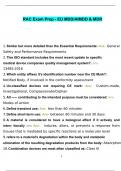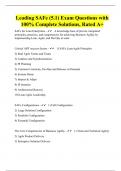Samenvatting
Summary All relevant notes from tutorial cases to pass the EPH2022 Exam (lifestyle, work and health in the EU)
- Instelling
- Maastricht University (UM)
This document is an extensive summary to all learning goals in all cases that took place in the EPH2022 module which was about the lifestyle, work and health in the EU. It includes the most important parts of the literature that you should know in order to well achieve in the exam. Make sure to fir...
[Meer zien]













